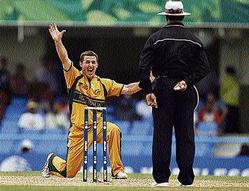
Tony BeccaThe World Cup of cricket is now well on the way and while the crowd, the attendance at the matches, has been disappointing; while the atmosphere at the matches has been disappointing; and, while the home team's performance also has been disappointing, the cricket, the action on the field, has been exciting - probably, so far the best ever.
Australia, the defending champions with four totals of over 300 and one 10-wicket victory in their five matches, have been setting the pace.
They have been followed by New Zealand who are also undefeated. And on top of that, with Ireland and Zimbabwe playing to a tie, with Ireland knocking out Pakistan, with Bangladesh destroying India, with Herschelle Gibbs smashing six sixes in one over, with India - before their departure - blasting 413 for five against Bermuda, and with Lasinth Malinga grabbing four wickets in four deliveries to lift the South Africa/Sri Lanka encounter to an exciting and thrilling finish, the action has been almost unbelievable.
Something forgotten
In the midst of the disappointment and the excitement, however, something has been forgotten, or almost forgotten and as far as fair play is concerned, as far as getting it right is concerned, as far as the umpires making the right decision is concerned, it is something that is good for the game.
From the beginning of time, from the beginning of the game as we know it, back in the 19th century, players - batsmen and bowlers alike - have been complaining, not so much about dishonest umpires, but more so about mistakes by umpires, mistakes that have robbed a bowler of a wicket, mistakes that have robbed a batsman of an innings, and mistakes that have assisted careers and destroyed careers.
Until recently, however, the powers that be - the International Cricket Council (ICC) - have been ignoring the call for help for the umpires, the kind of help that could come from the use of technology.
According to them, the umpires' word or action is final; according to them, the use of technology would waste too much time; and, according to them, it would take away from the authority of the umpire.
According to the players and others around the game, however, that was not important. According to them, what was important, what is important was that the correct decisions be made, that especially in this day and age of professionalism in the interest of both the batting team and the fielding team, of the batsman and the bowler, a batsman who is out is not given not out and most importantly, a batsman who is not out is not given out.
Powers backed off

Australia's Brad Hogg (left) appeals successfully to umpire Aleem Dar of Pakistan for the wicket of West Indies' Devon Smith during their World Cup cricket Super Eights match in St. Johns, Antigua, on March 28. - REUTERS
In recent years, however, the powers that be have backed off a bit and have allowed referrals in some cases like run-out and stumpings, to a third umpire who is guided by slow motion television.
The ICC, however, has now taken one more step in the right direction.
While there is nothing new with microphones in the stumps, there is something new with umpires being wired into the microphones. That is what is happening during the World Cup an the umpire still has to see as well as hear, that is good for the game.
Like commentators and like viewers on television, umpires can now also hear a snick or an edge whenever the ball clips the bat, an he still has to see, even though he cannot ask the third umpire for help, even though those decisions remain his and his alone, he is now in a better position to make the correct decision as to whether a batsman is out caught by the wicketkeeper or not, is leg before wicket or not.
That's great news for the game and especially so for a batsman who has not touched the ball but who is given out caught by the wicketkeeper, and for the batsman who snicks the ball into his pad and is given out.

